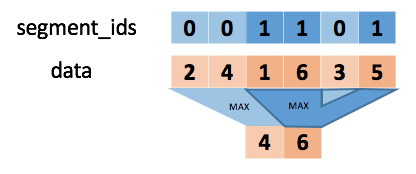mindspore.ops.unsorted_segment_max
- mindspore.ops.unsorted_segment_max(x, segment_ids, num_segments)[source]
Computes the maximum along segments of a tensor.
The following figure shows the calculation process of unsorted_segment_max:

where
Note
If the segment_id i is absent in the segment_ids, then output[i] will be filled with the minimum value of the x's type.
The segment_ids must be non-negative tensor.
- Parameters
- Returns
Tensor, the shape is
- Raises
TypeError – If num_segments is not an int.
- Supported Platforms:
AscendGPUCPU
Examples
>>> from mindspore import Tensor >>> from mindspore import ops >>> import numpy as np >>> x = Tensor(np.array([[1, 2, 3], [4, 5, 6], [4, 2, 1]]).astype(np.float32)) >>> segment_ids = Tensor(np.array([0, 1, 1]).astype(np.int32)) >>> num_segments = 2 >>> output = ops.unsorted_segment_max(x, segment_ids, num_segments) >>> print(output) [[1. 2. 3.] [4. 5. 6.]]